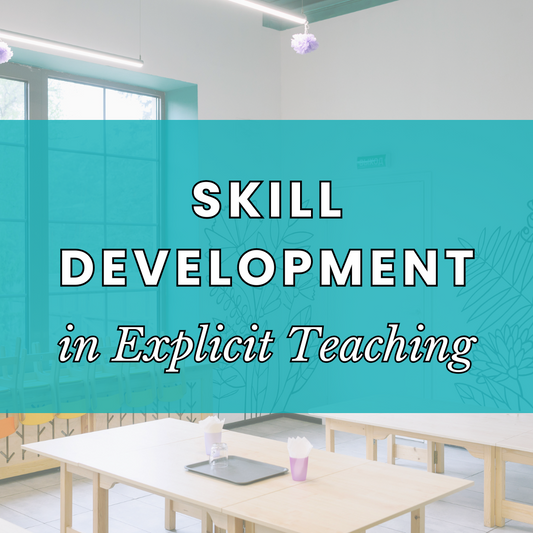
Graphic Organisers for Explicit Teaching
Share
The Ultimate Guide to Using Graphic Organisers in Explicit Teaching
Graphic organisers are one of the most versatile and impactful tools in explicit teaching. Not only do they provide clarity, but they also add structure and engagement, transforming your lessons into focused and effective learning experiences. Whether you’re teaching maths, literacy, science, or humanities, graphic organisers can help your students grasp new concepts, practise skills, and reflect on their learning.
In this guide, we’ll explore how to integrate graphic organisers into your explicit teaching approach, share practical tips for implementation, and showcase examples to inspire your next lesson.
Why Graphic Organisers Are Essential for Explicit Teaching
Explicit teaching thrives on structure and clarity, and graphic organisers are designed to deliver both. By visually breaking down complex concepts, these tools help students make sense of information and follow a clear path to success.
- Simplify Learning: Graphic organisers guide students step-by-step, reducing cognitive overload and helping them focus on the task at hand.
- Increase Engagement: Their visual nature keeps students interested and actively involved in the learning process.
- Promote Consistency: Using the same organiser across different lesson phases (I Do, We Do, You Do) reinforces learning and ensures students know what’s expected.
- Support All Learners: Graphic organisers can be easily adapted for students of varying abilities, making them an inclusive and effective resource.
Integrating Graphic Organisers into Explicit Teaching
Modelled Instruction (I Do)
During the I Do phase, the teacher demonstrates the skill or concept step-by-step, often using a graphic organiser as the foundation. This phase is about clarity—students watch and listen as you verbalise your thought process.
How to Use:
- Complete a worked example on the organiser in real time. Use “think alouds” to explain each step and why it’s important.
- Avoid pre-completed examples during this phase. Students benefit most from seeing the process unfold live.
- Example: In a maths lesson on fractions, use a T-chart to compare fractions with different denominators. Fill out one side of the organiser while explaining your reasoning.
Guided Practice (We Do)
Next, in the We Do phase, you and your students work together to practise the skill, gradually reducing your input as they gain confidence. Here, the graphic organiser becomes a shared tool, guiding collaborative learning.
How to Use:
- Revisit the same organiser used in the I Do phase. Simply change the numbers, text, or content to keep the task fresh.
- Encourage students to complete sections in pairs or small groups while you provide feedback and support.
Activity Ideas:
- Problem Pairs: Place a modelled example next to a similar problem for students to complete. This allows them to refer to the completed side as they work.
- Faded Guidance: Provide partially filled organisers for students to complete collaboratively.
- Step-by-Step Instruction: Guide students through one step at a time, completing each section together before moving on.
Independent Practice (You Do)
Finally, in the You Do phase, students should feel confident enough to tackle the graphic organiser independently. This phase solidifies their understanding and allows them to apply their skills in a structured way.
How to Use:
- Provide the same organiser format used in earlier phases, so students are familiar with the structure.
- Offer differentiated tasks to meet the needs of all learners. For instance, advanced students could include challenge questions or additional sections for deeper exploration.
Example: For a reading comprehension lesson, students can use a Venn diagram to compare two characters independently, drawing on insights from the guided practice phase.
Practical Tips for Using Graphic Organisers
-
Print and Laminate for Reuse Save time and resources by laminating organisers or using dry erase pockets. As a result, you can reuse them for multiple lessons and across different topics.
-
Display Step-by-Step Instructions Always include clear instructions for how to complete the organiser. This ensures students stay on track and don’t skip important steps.
-
Model the Process First Take the time to complete a worked example with your students before asking them to use the organiser. By verbalising your thoughts, you’ll show them how to approach the task.
-
Incorporate Interactive Elements Use organisers during peer discussions, group projects, or quick-response activities like “Show me” boards to keep students engaged.
-
Plan for Fast Finishers Have additional tasks or challenges ready for students who finish quickly. For example, they could create their own organiser to summarise a concept or extend their learning.
Examples of Graphic Organisers in Action
Graphic organisers are incredibly adaptable and can be used across a wide range of subjects. Here are some examples to inspire you:
-
Maths:
- Fact Family Chart: Help students visualise relationships between addition, subtraction, multiplication, and division.
- Flowchart for Multi-Step Problems: Guide students through each step of solving a complex problem.
-
Literacy:
- Story Map: Break down narrative elements like setting, plot, and resolution.
- Venn Diagram: Compare and contrast characters, themes, or ideas in a text.
-
Science:
- Cause-and-Effect Diagram: Explore the impact of variables in an experiment.
- Step-by-Step Lab Sheet: Outline the stages of an experiment with space for observations.
-
Humanities:
- Timeline: Organise historical events chronologically.
- SWOT Analysis: Evaluate the strengths, weaknesses, opportunities, and threats in a case study.
Why Graphic Organisers Are a Must-Have for Teachers
Graphic organisers are more than just a teaching tool—they’re a game-changer for explicit teaching. Not only do they provide structure and clarity, but they also make your lessons more effective and your students more confident learners. By integrating graphic organisers into your explicit teaching approach, you’ll save time while creating a consistent and supportive learning environment for your students.
Looking for More Ideas?
Dive deeper into strategies and examples in our blog posts:



